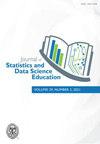用乐高积木数据建立多元线性回归模型
IF 1.6
Q2 EDUCATION, SCIENTIFIC DISCIPLINES
Journal of Statistics and Data Science Education
Pub Date : 2021-06-25
DOI:10.1080/26939169.2021.1946450
引用次数: 5
摘要
摘要:我们提出了一个创新的活动,利用乐高积木的数据来帮助学生自我发现多元线性回归。引导学生预测在亚马逊网站上发布的乐高套装的价格(亚马逊价格),使用乐高的特征,如块的数量,主题(即产品线),以及块的一般尺寸。通过图形显示和简单的线性回归,学生能够建立相加的多元线性回归模型以及交互模型来完成任务。我们提供了学生对活动的反应示例,并根据我们的经验为教师提供建议。本文的补充材料可在网上获得。本文章由计算机程序翻译,如有差异,请以英文原文为准。
Building a Multiple Linear Regression Model With LEGO Brick Data
Abstract We present an innovative activity that uses data about LEGO sets to help students self-discover multiple linear regressions. Students are guided to predict the price of a LEGO set posted on Amazon.com (Amazon price) using LEGO characteristics such as the number of pieces, the theme (i.e., product line), and the general size of the pieces. By starting with graphical displays and simple linear regression, students are able to develop additive multiple linear regression models as well as interaction models to accomplish the task. We provide examples of student responses to the activity and suggestions for teachers based on our experiences. Supplementary materials for this article are available online.
求助全文
通过发布文献求助,成功后即可免费获取论文全文。
去求助
来源期刊

Journal of Statistics and Data Science Education
EDUCATION, SCIENTIFIC DISCIPLINES-
CiteScore
3.90
自引率
35.30%
发文量
52
审稿时长
12 weeks
 求助内容:
求助内容: 应助结果提醒方式:
应助结果提醒方式:


